|
|
 |
| |
Natural Staking installation
view
[l-r]: Jacqui Hallum Natural Staking V, mixed
media* on canvas, 2015; Tamara Van San Close to
the Wind, synthetic gypsum, fluorescent and luminous
pigment, iron, fibreglass, 2015; Jacqui Hallum Natural
Staking I, mixed media* on cotton, 2015; Tamara
Van San Tiny Surge, polystyrene, 2015; Jacqui
Hallum Natural Staking IV, mixed media* on
canvas, 2015; Jacqui Hallum Natural Staking III,
mixed media* on canvas, 2015
|
| |
Natural Staking is an exhibition of new work
by Belgian sculptor Tamara Van San and British
painter Jacqui Hallum. The exhibition reflects
the fine balance held in each artist’s practice between
the provisional, the considered and the resolutely intentioned.
Materially, both artists devise extraordinary soups from which
the paintings and sculpture are distilled or drawn out. The
resultant works bear witness to this fluid, transformative process,
and they each acknowledge the eternal flux that refuses to allow
objects, even artefacts, to calcify their values and significances
once made. Change is embedded in the artists’ approach
to working with pigments and plastics (Van San), and crystal-forming
sulphates and porous substrates (Hallum). Fluidity is also acknowledged
in the language of forms and images, which linger like ruins
within the works’ constituent parts and in the experience
of their totality. The exhibition itself develops this feeling
for the impossibility of stasis by the artists’ dynamic
engagement with the architecture of the gallery and in the reflexive
relationship between the two artists’ works.
In her new series of un-stretched paintings, Jacqui
Hallum casually transcribes sections of a medieval
woodcut, greatly enlarged. Dürer’s image Knight
and Landsknecht (1497) is anachronistically re-cast as
Don Quixote and Sancho Panza, and it is the duality of these
two protagonists as they navigate the world experientially and
imaginatively that provides a metaphor for the relationships
between the areas of colour information that interrupt, animate
and camouflage the illustration fragment. Just as Dürer/Cervantes’
narratives provide a mutable framework for Hallum’s exploration
of non-static painting, so too the painting substrate is itself
a porous host for the stains and saturations, as well as the
reactive crystalline growth, that flicker and hum across its
surface.
Pigmented stains re-occur in Tamara Van San’s
new sculpture, but here they have become three-dimensional forms
that inhabit space rather than ingress the fabric of an object
or a surface. Of her process she says: “[I want] to make
colour stains like they are lying in a hammock. [Then] maybe
put them on their side, or build a wall…” Van San’s
desire to freeze and make solid something as insubstantial as
a stain requires a protracted and experimental negotiation with
her materials, which must be carefully trained to behave at
the edges of their intended function or purpose. Her embrace
of fluorescent pigments, which appear brighter than other colours
because they transform light wavelengths rather than merely
reflect light, and of installations, which formally re-organise
themselves as the viewer moves past, around or through them,
mean that whatever control she manages in the work’s making
is never entirely definitive.
The exhibition title refers to the horticultural practice of
employing one living plant to form the armature for another
to grow up and through. This method embraces contingency, change
and mutuality within gardening. And gardening is itself a mimetic
interpretation of that which lies somewhere beyond the garden
wall; it is a domesticated version of the natural world. So
too these works, through their making and in the continuum of
their transforming, speak modestly and eloquently of the world
and our negotiation of it.
|
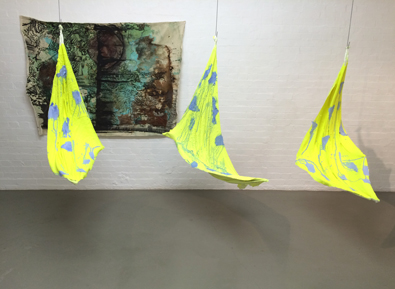 |
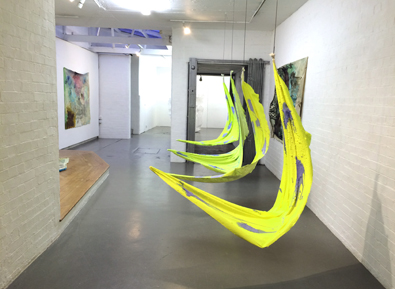 |
[foreground]:
Tamara Van San Close to the Wind, synthetic
gypsum, fluorescent and luminous pigment, iron, fibreglass,
2015
[back]:
Jacqui Hallum Natural Staking V, mixed media*
on canvas, 2015
|
|
|
| |
[foreground]:
Tamara Van San Close to the Wind, synthetic
gypsum, fluorescent and luminous pigment, iron, fibreglass,
2015
[back, l-r]:
Jacqui Hallum Natural Staking III, mixed media*
on canvas, 2015; Jacqui Hallum Natural Staking V,
mixed media* on canvas, 2015 |
|
|
| |
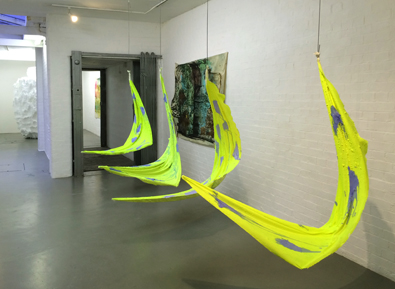 |
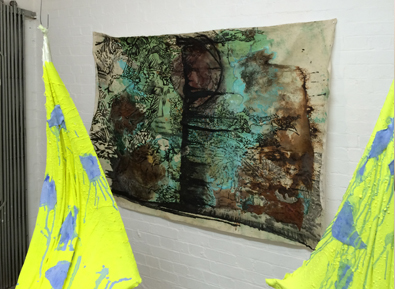 |
[foreground]:
Tamara Van San Close to the Wind, synthetic gypsum,
fluorescent and luminous pigment, iron, fibreglass, 2015
[back, l-r]:
Tamara Van San Surge, polystyrene, 2015; Jacqui Hallum
Natural Staking II, mixed media* on canvas, 2015;
Jacqui Hallum Natural Staking V, mixed media* on
canvas, 2015 |
[foreground]:
Tamara Van San Close to the Wind, synthetic gypsum,
fluorescent and luminous pigment, iron, fibreglass, 2015
[back]:
Jacqui Hallum Natural Staking V, mixed media* on
canvas, 2015 |
| |
|
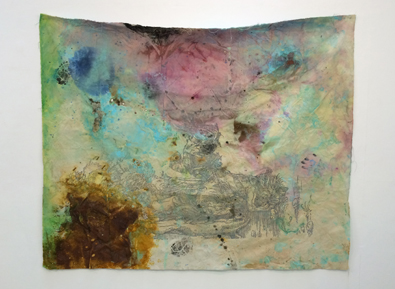 |
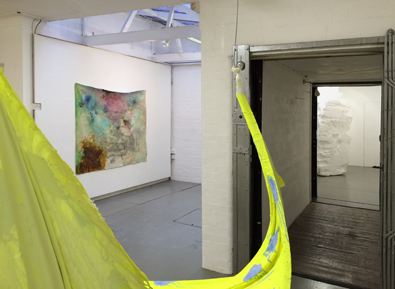 |
| Jacqui Hallum Natural Staking III,
mixed media* on canvas, 2015 |
[foreground]:
Tamara Van San Close to the Wind, synthetic gypsum,
fluorescent and luminous pigment, iron, fibreglass, 2015
[back, l-r]:
Jacqui Hallum Natural Staking III, mixed media* on
canvas, 2015; Tamara Van San Surge, polystyrene,
2015 |
| |
|
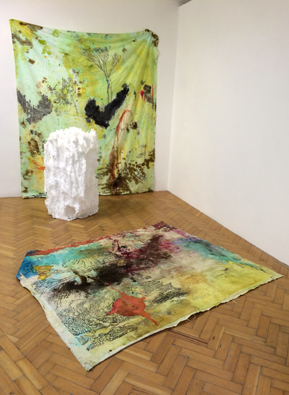 |
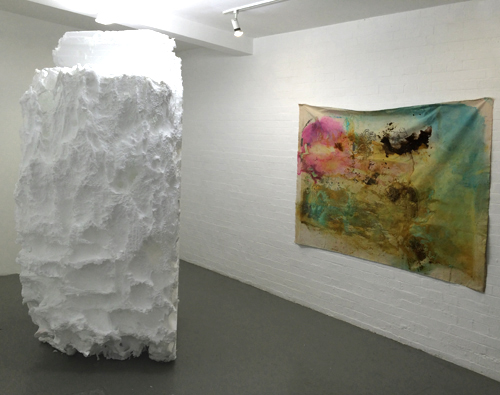 |
[front-back]:
Jacqui Hallum Natural Staking IV, mixed media*
on canvas, 2015; Tamara Van San Tiny Surge,
polystyrene, 2015; Jacqui Hallum Natural Staking
I, mixed media* on cotton, 2015 |
[l-r]:
Tamara Van San Surge, polystyrene, 2015; Jacqui
Hallum Natural Staking II, mixed media* on
canvas, 2015 |
|
| |
|
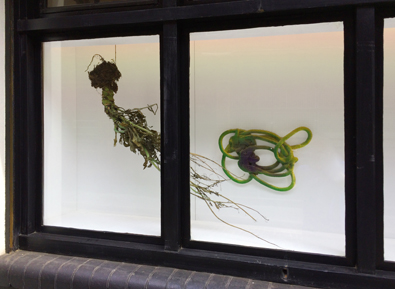 |
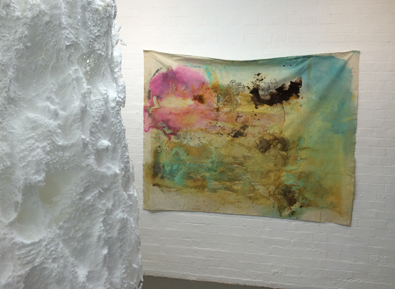 |
[l-r]:
Jacqui Hallum (The) High Priestess, bolted khol rabi,
2015; Tamara Van San Meta Knot, ceramic, paint,
2013 |
[l-r]:
Tamara Van San Surge, polystyrene, 2015; Jacqui Hallum
Natural Staking II, mixed media* on canvas, 2015 |
* The Natural Staking series is made with combinations
of the following substances: ink, oil, maroger medium, rain, copper
sulphate, malachite, red oxide, potassium permanganate, lycopodium,
magnesium sulphate, copper filings and iron filings
. |
Natural Staking
Standpoint, 45 Coronet Street, London N1 6HD
2nd - 31st October, 2015 |
 |
|














